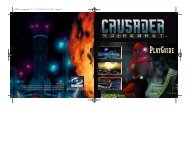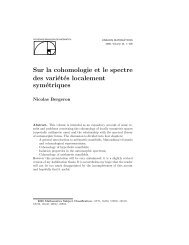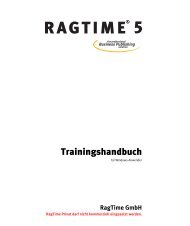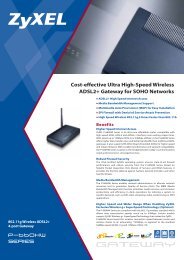RAIDWatch User's Manual
RAIDWatch User's Manual
RAIDWatch User's Manual
You also want an ePaper? Increase the reach of your titles
YUMPU automatically turns print PDFs into web optimized ePapers that Google loves.
<strong>RAIDWatch</strong> User’s <strong>Manual</strong><br />
1.2.4.2 Mode Two: Stand-alone (on Host)<br />
For configurations depending on the existing SCSI, iSCSI, or Fibre host<br />
connection for <strong>RAIDWatch</strong>-to-RAID communications. Servers in DAS<br />
(Direct Attached Storage) environments, SCSI host models for example,<br />
require RAID agents for <strong>RAIDWatch</strong> commands to pass through and<br />
communicate with RAID arrays. RAID agents are installed onto the servers<br />
that are directly attached with a RAID subsystem.<br />
1.2.4.3 Mode Three: Stand-alone (on Subsystems)<br />
For remote and server-transparent management using an Ethernet<br />
connection to EonStor subsystems or EonRAID controllers. The manager<br />
program is installed on the RAID subsystem itself. The RAID subsystem<br />
then uses a segregated disk space, called the “reserved space,” to store the<br />
program files. The array is accessed by invoking a Java Applet on a web<br />
browser that runs anywhere in the network.<br />
NOTE:<br />
RAID agents are embedded in the RAID subsystem firmware. When<br />
subsystems are installed in Mode 2 or Mode 3, the management station<br />
running in Mode 1 can manage the <strong>RAIDWatch</strong> components. This way,<br />
multiple and/or distant arrays can be managed by a single management<br />
station.<br />
1.2.4.4 Access Requirements<br />
Three (3) installation schemes for different access requirements are<br />
discussed below.<br />
NOTE:<br />
The discussions below do not include all possibilities. <strong>RAIDWatch</strong><br />
supports various configurations and the combinations of machines<br />
running components installed in any of the three different modes.<br />
1. A RAID Server Chosen as the Centralized Management Station:<br />
Applied in heterogeneous environments where multiple arrays are<br />
serving different hosts/applications and scattered in distant locations.<br />
Access management over the network is achieved through data<br />
exchanges between a local or remote <strong>RAIDWatch</strong> Manager station<br />
(can be a RAID server or not) and RAID agents that are installed on<br />
the RAID servers or RAID subsystems themselves. The management<br />
center and the <strong>RAIDWatch</strong> station can be two different machines.<br />
A Root agent is installed on a computer chosen to be the<br />
management center. Figure 1-4 shows a typical connection and<br />
1-6 Featured Highlights











